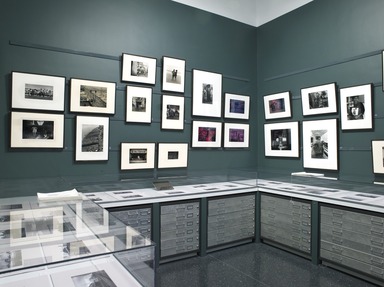
Goodbye Coney Island
DATES November 28, 2007 through April 06, 2008
ORGANIZING DEPARTMENT
Prints, Drawings and Photographs
COLLECTIONS
American Art
,
Photography
RELATED LINKS
Main Exhibition Page
-
Goodbye Coney Island?
Coney Island was always a contested playground. Disputes over land use occurred at every stage of its evolution from a remote seventeenth- and eighteenth-century farming area to the world’s amusement capital about 1900. Seventeenth-century power grabs by Dutch and English colonialists, late nineteenth-century corruption scandals, strict management by New York City Parks Commissioner Robert Moses in the mid-twentieth century, and present-day real estate speculations over valuable beachfront property are all part of the history of this small stretch of land on the Atlantic Ocean that has become synonymous with guilt-free fun and irreverent entertainment. In the past few years, structured attempts to rejuvenate the area have increased, signaling an interest in preserving Coney Island’s character and its accessibility for a socially and ethnically diverse audience. At the same time, developers have presented elaborate commercial and residential schemes that many fear would dramatically alter the nature of Coney.
With changes anticipated in the near future, this exhibition of photographs, most of them from the Brooklyn Museum collection, traces the evolution of Coney Island as an entertainment haven over the past 125 years. What will come out of the renewal efforts remains uncertain at the time of the preparations for this show. It seems likely, however, that Coney Island will yet again change guise as a new incarnation takes shape in the next decade.
Patrick Amsellem
Associate Curator of Photography -
Conyne Eylandt
Coney Island is a narrow, four-mile stretch of land in southern Brooklyn, not quite ten miles from Manhattan. Originally separated from the mainland by a small creek that was filled in during the first half of the nineteenth century, it was the westernmost of the barrier islands on the south shore of Long Island. It was here that Henry Hudson anchored his ship, the Half Moon, when he first arrived with the Dutch East India Company in 1609. The name Coney Island probably derives from the Dutch Conyne Eylandt (Rabbit Island), an epithet used by the first Dutch settlers in the seventeenth century who ousted the indigenous Canarsie population and used the rabbit-filled land as grazing ground for their farm animals. Until the early nineteenth century, only a few farmhouses occupied the mostly uninhabited island.
-
October 7, 2007
An exhibition of more than fifty photographs from the Brooklyn Museum’s holdings, Goodbye Coney Island? traces the evolution of this fabled part of New York over the past 125 years. Coney Island has undergone many transformations since it first became a popular resort in the nineteenth century, and a prospective redevelopment plan may yet again change this section of Brooklyn. The small exhibition will be on view from November 28, 2007–April 6, 2008, in the Brooklyn Museum’s Visible Storage ■ Study Center of the Luce Center for American Art.
Goodbye Coney Island? presents images that depict the area’s early life and its landmarks and attractions from the 1870s to the present, including the Oriental Hotel, Steeplechase, Luna Park, the beach and boardwalk, and the classic Thunderbolt rollercoaster. The exhibition will include photographs by Breading Way, George Bradford Brainerd, Stephen Salmieri, and Lynn Butler.
About a third of the photographs on view are contemporary prints of digitally scanned late-nineteenth and early-twentieth-century glass-plate negatives from the Brooklyn Museum collection.
This exhibition is organized by Patrick Amsellem, Associate Curator of Photography, Brooklyn Museum.
View Original
